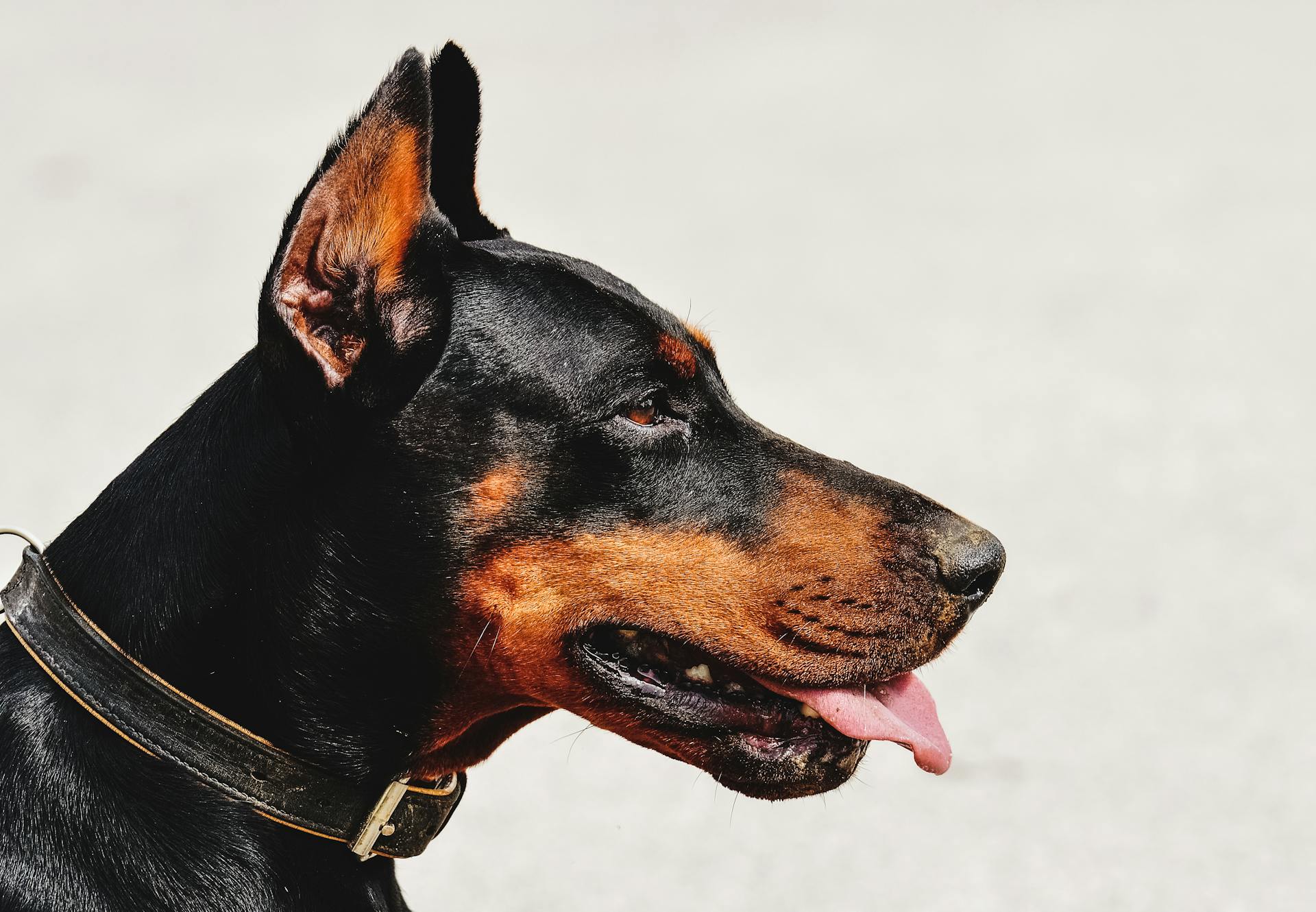
The Doberman Pinscher is often misunderstood, but its reputation as a "devil dog" is largely undeserved. This breed has been a loyal companion to many families for over a century.
Originally bred in Germany in the late 19th century, the Doberman Pinscher was designed to be a guard dog, not a fighting dog. Its intelligence, athleticism, and protective nature made it an ideal breed for this purpose.
Despite its intimidating appearance, the Doberman Pinscher is a loving and gentle breed that thrives on human interaction. With proper socialization and training, it can become a wonderful family pet.
Here's an interesting read: Doberman Pinscher Breed Standard
Physical Characteristics
Doberman Pinschers have a distinct physical appearance that's often intimidating, but it's also what makes them excel as personal protection dogs. Their large size is impressive, with males averaging between 75 to 100 pounds and 26 to 28 inches tall.
They're built for speed, strength, and stamina, with a muscular build and low body fat. In fact, they can run up to 40 mph and maintain these high speeds for an impressive length of time.
A broad, powerful chest is a key feature of the Doberman's physique, perfect for hitting large prey hard and taking them to the ground. Their proud posture is also noteworthy, with a unique ability to sit tall, alert, calm, and proud.
Their head shape is a blunt wedge, with a large portion taken up by their powerful jaws and large mouth. Traditionally, Dobermans have cropped ears that stand straight up, which was originally done to help locate the source of sound during guard work.
Their short, sleek coat makes it difficult to hold onto or control them in a fight. And, their docked tail is a result of their natural tails being long, thin, and prone to breaking.
Here are the average weight and height ranges for Doberman Pinschers:
History and Purpose
The Doberman Pinscher breed was created by Karl Friedrich Louis Dobermann in the late 1800s in Apolda, Germany.
Louis Dobermann was a tax collector and ran the local dog pound, giving him access to various breeds to use in his breeding experiments.
He needed a dog that was strong, fast, smart, fearless, loyal, trainable, and intimidating to potential attackers.
Louis selectively bred dogs to create the perfect protector, but he never documented exactly which breeds he used.
It's commonly believed that he used a combination of breeds like the greyhound, Rottweiler, German Shepherd, Great Dane, and German Pinscher.
The Doberman Pinscher was bred to be a recent creation, emerging only a little over a hundred years ago.
This selective breeding led to a dog that's completely loyal and very trainable, with a strong prey drive and a need for physical and mental stimulation.
The Doberman Pinscher was designed to be a ferocious protector if need be, with a large and intimidating presence that discourages potential attackers.
Consider reading: Doberman vs German Pinscher
Temperament and Behavior
Doberman Pinschers are often misunderstood, and one of the main reasons is their temperament and behavior. They're naturally reserved with strangers, but once they get to know you, they're warm and loving.
Dobermans have a strong instinct to protect their owners, which can sometimes be misinterpreted as aggression. If they sense something is off, they'll act to defend their pack. This is true even for the most docile Doberman.
They're incredibly loyal and love to stick by their owner's side. In fact, they're often referred to as "velcro dogs" because of their strong attachment. They'll defend their owners to the death and are very in-tune with people, bonding strongly with one specific family member.
Dobermans are also one of the smartest dog breeds in the world, consistently ranked among the top. They're great at problem-solving, following commands, and understanding what's expected of them. This intelligence makes them highly trainable.
Here are some key temperament traits of Doberman Pinschers:
- Reserved with strangers
- Protective of their owners
- Loyal and loving
- Intelligent and trainable
Do They Need My Help?
Dobermans are often misunderstood, but they're actually incredibly loving and gentle dogs. They're even used as service dogs due to their intelligence, trainability, and kind nature.

They're also very loyal, and love to stick by the side of their owners. This is why they're often referred to as "velcro dogs." They love their owners and will defend them to the death.
If you're wondering if a Doberman needs your help, you might be surprised to know that many Dobermans are in need of rescue or rehoming. The UK's Dobermann Rescue is one organization that tries to help.
Dobermans are naturally reserved with strangers, but once they get to know you, they'll show a very warm side. This means they can take time to warm up to new people, but once they do, they'll be your best friend.
If you're thinking of helping a Doberman in need, there are probably animal charities local to you that could use your support.
Explore further: Dobermans Good Apartment Dogs
General Temperament
Dobermans are known for their unique temperament, which can sometimes be misunderstood. They're naturally reserved with strangers, but once they get to know you, they'll show a warm and loving side.
A Doberman's primary instinct is to protect its owners, which is why they make great guard dogs. If they sense something's off, they'll act quickly to defend their family.
One of the most endearing traits of Dobermans is their loyalty. They bond strongly with their owners and are often referred to as "velcro dogs" because they love to stick close by.
Dobermans are also incredibly intelligent, consistently ranking among the smartest dog breeds in the world. This intelligence makes them highly trainable and great problem-solvers.
Here are some key temperament traits of Dobermans:
- Reserved with strangers
- Protective of their owners
- Loyal and loving
- Intelligent and trainable
As a result of their breeding history, Dobermans have a strong instinct to protect their owners, but they're not naturally aggressive. With proper socialization, they can make wonderful family pets and loving companions.
Safety and Statistics
Doberman Pinschers have a bad reputation, but the facts don't entirely support it. A thirteen-year study found that Dobermans ranked 11th in fatal dog attacks, with a total of 6 deaths.
Many people believe that Dobermans are prone to randomly snapping, but this is a common myth. In reality, Dobermans are loving animals that are generally well-suited for companionship roles.
The physical abilities of Dobermans can be intimidating, but they're just great loyal protectors. They're large, strong, and have a powerful bite, which can be a concern for those who don't know them.
According to the study, Pit bulls were responsible for 65.6% of fatal dog attacks during the thirteen-year period. This is a stark contrast to the common perception of Dobermans as "devil dogs."
The statistics are clear: Dobermans are not as likely to kill someone as other breeds. In fact, the Labrador retriever killed more people during the study period than Dobermans did.
Here's a breakdown of the breeds involved in fatal dog attacks during the thirteen-year study:
Sources
- https://vault.si.com/vault/1958/05/12/the-doberman-pinscher-darlingor-devil
- https://coffeeandcreatures.co.uk/2020/01/14/doberman-pinscher-facts/
- https://www.dobermanplanet.com/are-dobermans-mean-dangerous-or-aggressive/
- https://www.ladobies.com/timeline
- https://medium.com/@robin_96329/the-polarizing-phenomenon-of-walking-a-doberman-899ba1e16564
Featured Images: pexels.com


